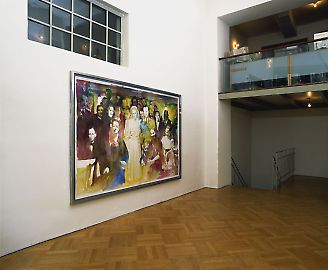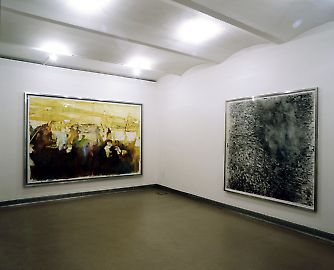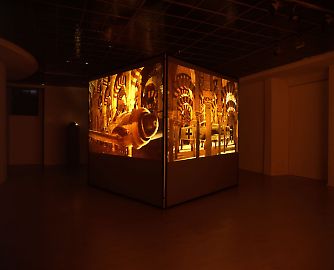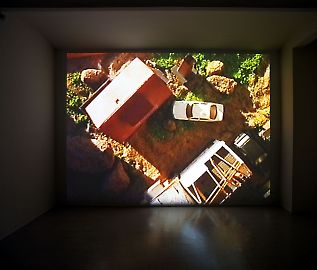Martin Dammann -- Vanishing Point
The artist Martin Dammann addresses a highly emotional and topical issue, i.e. the interplay between war, media coverage and its impact on our perception. Original photos and footage from around WWI. to the Kosovo conflict and the standard methods of modern warfare form the basis of the large-size water-colour paintings, video works and photo series put on show. The artist draws inspiration and material from his work for the London-based Archives of Modern Conflict as he has been in charge of acquiring photos for the collection specialising in private war photography for some years.
The first section of the exhibition highlights the latest works of the painter Martin Dammann. Photos of military and war scenes or partly private pictures, idyllic at first sight but evoking associations with war on closer inspection, serve as a model for his more than 2-metre large watercolours. “I am not interested in the photo as such but in the occasion giving rise to it“ (quote: Martin Dammann). The artist cautiously approaches the medium of photography and deprives the brief moment in which the photo was taken of any claim to reality by transforming it with the “soft“ technique of watercolour painting. This allows the onlooker to engage in a novel, subjective play of interpretation.
His video Abgang produced in 2003 shows a bird’s eye view of a model landscape with loosely placed cars, buildings, etc. falling from the 4th floor of a residential building. The video camera, which was also dropped from the building but caught falling by a bungee-jumping rope, filmed the successive disintegration of the model during free fall and its complete destruction through the impact. At the moment of disintegration the camera briefly seems to fly through space and to transmit images of stumbling rocks and houses. The subsequently appearing real scenery of a backyard spotlights the viewers’ desire for the dissolution of their own world and images. For the video Wo created in 1999 during his stay in London Dammann filmed the landing of passenger air planes at Heathrow trying to focus on the exact point where the air planes that had disappeared in the clouds were re-emerging. Most of the time the viewer is faced with a white screen of clouds, which reveals those aspects making aware of the nonvisible.
Martin Dammann uses photos from the collection of the Archives of Modern Conflict in London as models for the largeformat series of reproductions titled Überdeutschland. The pictures taken from air planes and hot-air balloons during WWII. do not show the reality of the war but the failure of photography to depict this reality. In the extremely sharp and large prints of the (small) originals the reality of the depicted object blends with the materiality of the photographic paper. The selection of aerial photos reflects the focus of reconnaissance photos on surveillance playing a crucial role especially in modern warfare. The large-format works impress for their physical presence and force the onlooker to view them from some distance. At the same time, they lend a dimension of horror to the meaning of the motif and the historical testimony of the selected material and seem to be anchored in the present.
Dammann’s walk-in installation Mezquita consists in a 3 x 3 x 3 m cube. The walls from reflective foil show both from the inside and outside three views of a war plane mounted in the “forest of columns” of the Mezquita (mosque) in Cordoba/Spain. Standing in the cube, the visitors can experience the air plane simultaneously from three different perspectives, which always seems to define their respective position. Through the multi-focal view, the onlooker seems to be swept away by the paradoxical feeling of being in the centre of a panorama but being unable to find a clear position in the physically real space. With this work created in 1996, which is now again of great topical interest due to the conflict between Islam and the Western world, Martin Dammann addresses the repetition of the clash of two formal principles. The originally Moorish mosque of the 8th century, which was Christianised and partly transformed into a Cathedral in the 16th century by Charles V., is subject to another confrontation as its static architecture is penetrated by the implicitly dynamic body of a war aircraft.
It is the “strong” wartime images that emotionally touch the artist. As Dammann transforms them into different media the onlooker is confronted with two semantic fields: the individual, personal on the one hand and the general powerful impact of images and historiography on the other hand. The subject highlighted is the changed perception of reality due to the growing influence of mass-mediasation on our personal attitudes and values. All works on show have to do with dissolution, penetration and disappearance and are linked by the longing for reaching a point of reality in the images that is outside themselves, a point that seems to gradually move away. Vanishing point.








